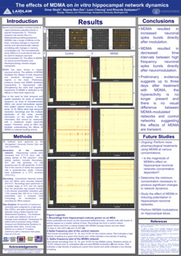Week 5 and 6 Update
During Weeks 5 and 6, a significant portion of the research activities focused on the analysis of the data collected during Weeks 3 and 4. Due to the substantial amount of raw data, comprising more than 20 minutes, it became necessary to isolate spike data and condense the evaluated time interval. For this purpose, a comparative analysis was conducted between the control MEA and the MDMA-modulated MEA, specifically focusing on the initial three days of recording.
To initiate the analysis, a minute-long segment of activity was extracted from each raw recording. Microchannel systems software was employed to extract spike data and generate raster plots, which served the purpose of characterizing the frequency and time intervals between spikes. Once raster plots were obtained for each recording on days 15, 18, and 19, the process of drawing conclusions commenced.
The findings revealed that MDMA induced an increase in neuronal spike bursts immediately following modulation, while concurrently decreasing the time interval between high spike density bursts. Furthermore, it was observed that the effects of MDMA were transient, as by DIV 18, the neuronal activity had returned to a normal state. It is essential to note that these observations solely pertain to cultured hippocampal cells and do not extend to the broader impact of MDMA on other regions of the brain.
Utilizing the generated plots and drawing from the conclusions, the subsequent focus of the research has been devoted to the development of a poster. I anticipate the opportunity to build upon my Laidlaw research in future projects, enabling further exploration of the electrophysiological effects of MDMA.


Please sign in
If you are a registered user on Laidlaw Scholars Network, please sign in